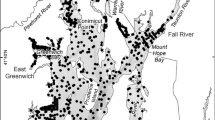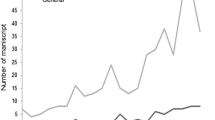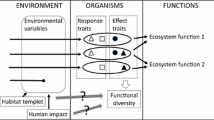Abstract
The use of databases for the conservation of biodiversity is increasing. During the last decade, such a database has been created for European stream macroinvertebrates. Today, it includes 527 sites that are the least human-impacted representatives of many stream types across many European regions. It includes data on the abundance of 312 invertebrate genera, several environmental site characteristics, collection methods, bibliographic data sources, and 11 biological traits of the genera (e.g. size, life cycle, food and feeding habits, described in 61 categories). The database will be useful in addressing many topics that are potentially relevant to biodiversity conservation. To illustrate this potential, we provide examples of how the data could be exploited. First, we describe the frequency of some taxonomic and biological characteristics (e.g. richness and diversity of genera and traits) of the macroinvertebrate communities and assess how these characteristics are related (e.g. how trait richness increases with genus richness). Second, we describe the frequency of some characteristics of the genera and traits (e.g. occurrence frequency, abundance, dispersion index) and again assess how these characteristics are related (e.g. how occurrence increases with abundance). Finally, we suggest how the database could be developed into a collective, publicly accessible database that covers stream types and regions of Europe more comprehensively.






Similar content being viewed by others
References
Acuña V (2004) Riparian forest and hydrology influences on the ecosystem structure and function of a Mediterranean stream. PhD thesis, University of Barcelona, Barcelona
Alba-Tercedor J, Jiménez-Millán F (1985) Evaluación de las variaciones estacionales de la calidad de las aguas del río Guadalfeo basada en el estudio de las comunidades de macroinvertebrados acuáticos y de los factores físico-químicos. Proyecto LUCDEME III. Monografías 48. Instituto Nacional para la Conservación de la Naturaleza (ICONA), Madrid
Alba-Tercedor J, Capitán-Vallvey LF, Espigares-García M (1990) Estudio de las condiciones ecológicas, sanitarias, químicas y de calidad de las aguas de la cuenca media-alta del río Guadalquivir. Report to the Dirección General de Obras Hidráulicas, Confederación Hidrográfica del Guadalquivir, Granada
Allan JD (1995) Stream ecology. Chapman and Hall, London
Barber WE, Kevern NR (1974) Seasonal variation of sieving efficiency in a lotic habitat. Freshwater Biol 4:293–300
Bêche LA, McElravy EP, Resh VH (2006) Long-term seasonal variation in the biological traits of benthic macroinvertebrates in two Mediterranean-climate streams in California, U.S.A. Freshwater Biol 51:56–75
Bonada N, Prat N, Resh VH, Statzner B (2006) Developments in aquatic insect biomonitoring: a comparative analysis of recent approaches. Annu Rev Entomol 51:495–523
Bonada N, Rieradevall M, Prat N (2000) Biodiversitat i qualitat de l’aigua a la riera de Sant Cugat (Collserola, Barcelona). In: Llimona F, Espelta JM, Guix JC, Mateos E, Rodríguez-Teijeiro JD (eds) I Jornades Sobre la Recerca en el Sistemes Naturals de Collserola: Aplicacions a la Gestió del Parc. Consorci Parc de Collserola, Barcelona, pp 45–49
Bournaud M (1994) Theoretical habitat templets, species traits, and species richness: birds in the Upper Rhône River and its floodplain. Freshwater Biol 31:469–485
Braukmann U (1984) Biologischer Beitrag zu einer allgemeinen regionalen Bachtypologie. PhD thesis, University of Giessen, Giessen
Cazaubon A, Giudicelli J (1999) Impact of the residual flow on the physical characteristics and benthic community (algae, invertebrates) of a regulated mediterranean river, the Durance, France. Regul Rivers Res Manage 15:441–461
Charvet S, Statzner B, Usseglio-Polatera P, Dumont B (2000) Traits of benthic macroinvertebrates in semi-natural French streams: an initial application to biomonitoring in Europe. Freshwater Biol 43:277–296
Chessel D, Dufour AB, Thioulouse J (2004) The ade4 package. I. One-table methods. R News 4:5–10
Chevenet F, Dolédec S, Chessel D (1994) A fuzzy coding approach for the analysis of long-term ecological data. Freshwater Biol 31:295–309
Dolédec S, Olivier J-M, Statzner B (2000) Accurate description of the abundance of taxa and their biological traits in stream invertebrate communities: effects of taxonomic and spatial resolution. Arch Hydrobiol 148:25–43
Dolédec S, Statzner B, Bournaud M (1999) Species traits for future biomonitoring across ecoregions: patterns along a human-impacted river. Freshwater Biol 42:737–758
Elliott JM (1977) Some methods for the statistical analysis of samples of benthic invertebrates, 2nd edn. Freshwater Biological Association, Scientific Publication 25, Ambleside, UK
Elliott JM, Mann KH (1979) A key to the British freshwater leeches with notes on their life cycles and ecology. Freshwater Biological Association, Scientific Publication 40, Ambleside, UK
Freitag S, Van Jaarsveld AS, Biggs HC (1997) Ranking priority biodiversity areas: an iterative conservation value-based approach. Biol Conserv 82:263–272
Gachet S, Véla E, Tatoni T (2005) BASECO: a floristic and ecological database of Mediterranean French flora. Biodivers Conserv 14:1023–1034
Gallardo A, Toja J (1989) Efecto de la contaminación orgánica en los macroinvertebrados acuáticos en la cuenca del río Guadaira (Sevilla, SW España). In: Machado-Cruz J (ed) Actas Colóquio Luso-Espanhol Ecología Bacias Hidrográficas Recursos Zoológicos. Instituto de Zoologia e estaçao de zoologia marítima Dr. Augusto Nobre, Faculdade de Cièncias, Universidade do Porto, Porto, Portugal, pp 163–170
Gallardo-Mayenco I (1993) Respuesta de macroinvertebrados fluviales a la salinidad. Comparación de las cuencas de los río Guadaira y Guadalete. PhD thesis, University of Sevilla, Sevilla
Gaston KJ (1994) Rarity. Chapman and Hall, London
Gordon ND, McMahon TA, Finlayson BL (1992) Stream hydrology. Wiley & Sons, Chichester
Guerrero C (2002) Patrones ecológicos y respuesta de la comunidad de macroinvertebrados acuáticos al estiaje. El caso del río Chícamo (SE de España). PhD thesis, University of Murcia, Murcia
Heino J, Paavola R, Virtanen R, Muotka T (2005) Searching for biodiversity indicators in running waters: do bryophytes, macroinvertebrates, and fish show congruent diversity patterns? Biodivers Conserv 14:415–428
Hynes HBN (1961) The invertebrate fauna of a Welsh mountain stream. Arch Hydrobiol 57:344–388
Illies J (ed) (1978) Limnofauna Europaea, 2nd edn. Fischer Verlag, Stuttgart
Jennings S, Greenstreet SPR, Reynolds JD (1999) Structural change in an exploited fish community: a consequence of differential fishing effects on species with contrasting life histories. J Anim Ecol 68:617–627
Lamouroux N, Dolédec S, Gayraud S (2004) Biological traits of stream macroinvertebrate communities: effects of microhabitat, reach and basin filters. J North Am Benthol Soc 23:449–466
Laurent PJ (1997) Introductions d’écrivisses en France et dans le monde, historique et conséquences. Bulletin Français de la Pêche et Pisciculture 344/345:345–356
Lei F-M, Qu Y-H, Tang Q-Q, An S-C (2003) Priorities for the conservation of avian biodiversity in China based on the distribution patterns of endemic bird genera. Biodivers Conserv 12:2487–2501
Lenat DR, Resh VH (2001) Taxonomy and stream ecology – the benefits of genus- and species-level identifications. J North Am Benthol Soc 20:287–298
Lévêque C, Balian EV, Martens K (2005) An assessment of animal species diversity in continental waters. Hydrobiologia 542:39–67
Martínez B, Velasco J, Suárez ML, Vidal-Abarca MR (1998) Benthic organic matter dynamics in an intermittent stream in South-East Spain. Arch Hydrobiol 141:303–320
Mérigoux S, Dolédec S, Statzner B (2001) Species traits in relation to habitat variability and state: neotropical juvenile fish in floodplain creeks. Freshwater Biol 46:1251–1267
Merritt RW, Cummins KW, Resh VH (1978) Collecting, sampling, and rearing methods for aquatic insects. In: Merritt RW, Cummins KW (eds) An introduction to the aquatic insects of North America. Kendall/Hunt, Dubuque, Iowa, pp 13–28
Miñano J (1994) Efectos de una avenida sobre la comunidad de invertebrados acuáticos en una rambla del Sureste Ibérico: Rambla del Judío (Cuenca del Río Segura). PhD thesis, University of Murcia, Murcia
Moreno JL (1994) Limnología de las ramblas litorales de la región de Murcia (SE de España). MSc thesis, University of Murcia, Murcia
Moreno JL (2003) Hábitats, recursos tróficos y estructura de la comunidad de macroinvertebrados bentónicos en un arroyo salino del SE Ibérico (Rambla del Reventón). PhD thesis, University of Murcia, Murcia
Naeem S, Li S (1997) Biodiversity enhances ecosystem reliability. Nature 390:507–509
Ortega M, Suárez ML, Vidal-Abarca MR, Ramírez-Díaz L (1991) Aspectos dinámicos de la composición y estructura de la comunidad de invertebrados acuáticos de la Rambla del Moro después de una riada (Cuenca del río Segura: SE de España). Limnetica 7:11–24
Pearson RG, Litterick MR, Jones NV (1973) An air-lift for quantitative sampling of the benthos. Freshwater Biol 3:309–315
Peters RH (1983) The ecological implications of body size. Cambridge University Press, Cambridge, UK
Picazo-Muñoz J (1995) Caracterización y calidad de las aguas de los cauces de la cuenca del río Guadiana menor. Aspectos físico-químicos y macroinvertebrados acuáticos. PhD thesis, University of Granada, Granada
Ribera I, Dolédec S, Downie IS, Foster GN (2001) Effect of land disturbance and stress on species traits of ground beetle assemblages. Ecology 82:1112–1129
Rieradevall M, Prat N (1997) La qualitat biològica de les aigües del Parc Natural de Sant Llorenç del Munt i la Serra de l’Obac. Diputació de Barcelona, Barcelona
Roberts RL, Donald PF, Fisher IJ (2005) Worldbirds: developing a web-based data collection system for the global monitoring of bird distribution and abundance. Biodivers Conserv 14:2807–2820
Sakai AK, Allendorf FW, Holt JS, Lodge DM, Molofsky J, With KA, Baughman S, Cabin RJ, Cohen JE, Ellstrand NC, McCauley DE, O’Neil P, Parker IM, Thompson JN, Weller SG (2001) The population biology of invasive species. Annu Rev Ecol Syst 32:305–332
Seely MK, Zeidler J, Henschel JR, Barnard P (2003) Creative problem solving in support of biodiversity conservation. J Arid Environ 54:155–164
Smith AT, Boitani L, Bibby C, Brackett D, Corsi F et al (2000) Databases tailored for biodiversity conservation. Science 290:2073–2074
Statzner B (1987) Characteristics of lotic ecosystems and consequences for future research directions. In: Schulze ED, Zwölfer H (eds) Potentials and limitations of ecosystem analysis. Springer Verlag, Berlin, pp 365–390
Statzner B, Bady P, Dolédec S, Schöll F (2005) Invertebrate traits for the biomonitoring of large European rivers: an initial assessment of trait patterns in least impacted river reaches. Freshwater Biol 50:2136–2161
Statzner B, Bis B, Dolédec S, Usseglio-Polatera P (2001a) Perspectives for biomonitoring at large spatial scales: a unified measure for the functional composition of invertebrate communities in European running waters. Basic Appl Ecol 2:73–85
Statzner B, Dolédec S, Hugueny B (2004) Biological trait composition of European stream invertebrate communities: assessing the effects of various trait filter types. Ecography 27:470–488
Statzner B, Hildrew AG, Resh VH (2001b) Species traits and environmental constraints: entomological research and the history of ecological theory. Annu Rev Entomol 46:291–316
Statzner B, Resh VH, Dolédec S (eds) (1994) Ecology of the upper Rhône river: a test of habitat templet theories. Freshwater Biol 31:253–554
Suberkropp K (2001) Fungal growth, production, and sporulation during leaf decomposition in two streams. Appl Environ Microbiol 67:5063–5068
Tachet H, Richoux P, Bournaud M, Usseglio-Polatera P (2002) Invertébrés d’Eau Douce (2nd corrected impression). CNRS éditions, Paris
Ter Braak CJF (1988) Partial canonical analysis. In: Block HH (ed) Classification and related methods of data analysis. Elsevier, Amsterdam, pp 551–558
Tittizer T, Schöll F, Banning M, Haybach A, Schleuter M (2000) Aquatische Neozoen im Makrozoobenthos der Binnenwasserstraßen Deutschlands. Lauterbornia 39:1–72
Tittizer T, Schöll F, Dommermuth M (1994) The development of the macrozoobenthos in the river Rhine in Germany during the 20th century. Water Sci Technol 29:21–28
Tixier G, Guérold F (2005) Plecoptera response to acidification in several headwater streams in the Vosges Mountains (northeastern France). Biodivers Conserv 14:1525–1539
Tofts R, Silvertown J (2000) A phylogenetic approach to community assembly from a local species pool. Proc Royal Soc London B 267:363–369
Townsend CR, Hildrew AG (1994) Species traits in relation to a habitat templet for river systems. Freshwater Biol 31:265–276
Usseglio-Polatera P, Bournaud M, Richoux P, Tachet H (2000) Biological and ecological traits of benthic freshwater macroinvertebrates: relationships and definition of groups with similar traits. Freshwater Biol 43:175–205
Van Swaay C, Warren M (1999) Red data book of European butterflies (Rhopalocera). Nature and Environment No. 99, Council of Europe, Strasbourg
Voelz NJ, McArthur JV (2000) An exploration of factors influencing lotic insect species richness. Biodivers Conserv 9:1543–1570
Ward JV (1992) Aquatic insect ecology. 1. Biology and habitat. Wiley & Sons, New York
Ward JV, Tockner K (2001) Biodiversity: towards a unifying theme for river ecology. Freshwater Biol 46:807–819
Weiher E, Keddy PA (1995) Assembly rules, null models, and trait dispersion: new questions from old patterns. Oikos 74:159–164
Werner U, Buszko J (2005) Detecting biodiversity hotspots using species-area and endemics-area relationships: the case of butterflies. Biodivers Conserv 14:1977–1988
Williams DD (1987) The ecology of temporary waters. Croom Helm, London
Zamora-Muñoz C (1991) Macroinvertebrados acuáticos, caracterización y calidad de las aguas de los cauces de la cuenca alta del río Genil. PhD thesis, University of Granada, Granada
Zamora-Muñoz C, Alba-Tercedor J (1992) Caracterización y Calidad de las Aguas del Río Monachil (Sierra Nevada, Granada). Factores Físico-químicos y Comunidades de Macroinvertebrados Acuáticos. Ediciones Anel, Albolote, Spain
Zamora-Muñoz C, Madrid-Vinuesa F, Alba-Tercedor J (1996) Estudio preliminar del efecto del embalse de canales en la comunidad de macroinvertebrados acuáticos del río Genil. In: Chacón J, Rosua JL (eds) Actas 1ª Conferencia Internacional Sierra Nevada: Conservación y Desarrollo Sostenible, vol II. Tiasa Gráfica, Granada, pp 187–203
Acknowledgements
We thank all researchers and editors who published results in a format such that we could use them for our database and the many colleagues that provided personal information to fill data gaps (all mentioned in previous papers that used the data). We particularly thank our Iberian colleagues who generously provided so many published and unpublished Mediterranean data and agreed that these could be made accessible to others: Vicenç Acuña, Isabel Muñoz, Narcís Prat, Maria Rieradevall, Carolina Solà, Mireia Vila (all at the University of Barcelona), Maria Luisa Suárez, Chary Vidal-Abarca (both at the University of Murcia), Nuno Coimbra, Manuel Graça (both at the University of Coimbra), Javier Alba-Tercedor, Carmen Zamora-Muñoz (both at the University of Granada), Alfonso Gallardo-Mayenco (University of Sevilla), and José Luis Moreno (University of Castilla-La-Mancha). We sincerely thank Henri Tachet for permission to provide on-line access to the modified and expanded trait information of Tachet et al. (2002) (under the condition that this key source of the trait data will be cited when used in publications by others). Finally, we thank two anonymous referees and Robert H. Cowie for comments on the manuscript.
Author information
Authors and Affiliations
Corresponding author
Appendices
Appendix 1
Biological traits and their categories in the database.
-
(1)
Maximum size (mm): ≤2.5; >2.5–5; >5–10; >10–20; >20–40; >40–80; >80.
-
(2)
Life cycle duration (yr): ≤1; >1.
-
(3)
Potential number of reproduction cycles per year: <1; 1; >1.
-
(4)
Aquatic stages: egg; larva; nymph; imago.
-
(5)
Reproduction: ovoviviparity; isolated eggs, free (not fixed to a substrate); isolated eggs, cemented; clutches, cemented or fixed; clutches, free; eggs or clutches in vegetation (endophytic); clutches, terrestrial; asexual reproduction.
-
(6)
Dispersal: aquatic passive; aquatic active; aerial passive; aerial active.
-
(7)
Mechanisms for resistance against unfavourable conditions: eggs, statoblasts, gemmules; cocoons; using refuges (e.g. small crevices) to resist desiccation during droughts; diapause or dormancy; none.
-
(8)
Respiration technique: tegument; gill; plastron; spiracle or hydrostatic vesicle (aerial).
-
(9)
Locomotion and substrate relation: flier; surface swimmer; swimmer; crawler; burrower (epibenthic); interstitial (endobenthic); temporarily attached; almost permanently attached.
-
(10)
Food: fine sediment and microrganisms; detritus <1 mm; plant detritus ≥1 mm; living microphytes; living macrophytes; dead animals ≥1 mm; living microinvertebrates; living macroinvertebrates; vertebrates.
-
(11)
Feeding habits: deposit feeder; shredder; scraper; filter-feeder; piercer (plants or animals); predator (carver/engulfer/swallower); parasite, parasitoid.
Appendix 2
Regarding further development of the database, the majority of colleagues we consulted for advice agreed to develop the database in two steps. The first step would be to use the database as a collective research tool. For this purpose, the data described herein will be implemented in an operational database by Klement Tockner at the Swiss Federal Institute for Environmental Science and Technology (http://www.eawag.ch/∼tockner/∼EuropeanRivers). Access to this research tool will be provided to potential users who have contributed or will add information to the database. Hopefully, such a collective research tool is sufficiently attractive to others that the coverage of European regions and stream types will be rapidly improved. After this improvement is achieved, the second step would be to convert the database into a user-friendly form enabling all sorts of searches and queries and to link it to other existing biodiversity databases (e.g. http://www.freshwaterlife.org/) that are freely accessible to the public.
Rights and permissions
About this article
Cite this article
Statzner, B., Bonada, N. & Dolédec, S. Conservation of taxonomic and biological trait diversity of European stream macroinvertebrate communities: a case for a collective public database. Biodivers Conserv 16, 3609–3632 (2007). https://doi.org/10.1007/s10531-007-9150-1
Received:
Accepted:
Published:
Issue Date:
DOI: https://doi.org/10.1007/s10531-007-9150-1




